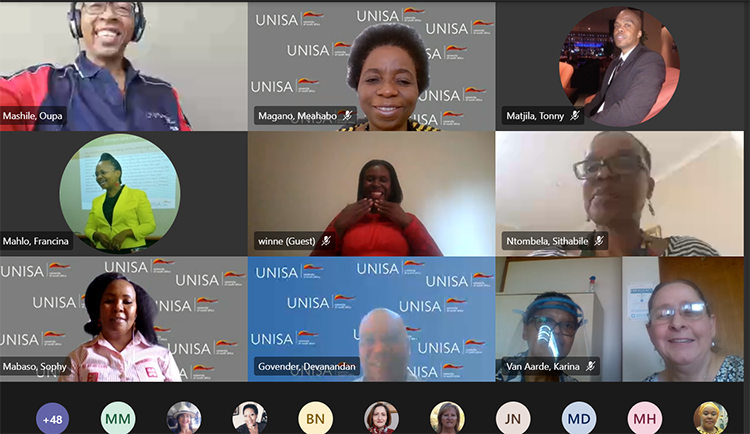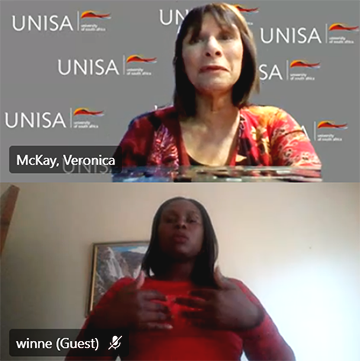
Producing over 40% of teachers in South Africa
On 30 October 2020, Unisa hosted the first webinar to celebrate the launch of the South African Sign Language (SASL) project titled In readiness of the 12th official language to accelerate transformation and reaffirm human rights of persons living with disabilities.

Delegates at the first South African Sign Language (SASL) webinar at Unisa
In March 2020, the Unisa College of Education (CEDU) asked Professor Oupa Mashile, Executive Director of the Department of Tuition Support and Facilitation of Learning (DTSFL), to assist with the design and development of SASL for the university.
The project cascaded down to the Directorate of Curriculum Development and Transformation (DCDT) for execution and culminated in a stakeholder workshop attended by several internal and external stakeholders, including the Deaf Federation of South Africa (DeafSA), committing to follow a dual approach to the roll out of SASL in the university by hosting a series of webinars and developing a short learning programme concurrently.

Prof Veronica McKay (Acting VP: TLCESS) and Winnie Ngobeni (Sign Language Interpreter)
Delivering her opening remarks, Professor Veronica McKay, Acting Vice-Principal of Teaching, Learning, Community Engagement, and Student Support (TLCESS), stated that SASL is mentioned in four South African laws, specifically the Constitution, the Use of Official Languages Act, the South African Schools Act, and the Pan South African Language Board Act. McKay explained that each country has its own sign language, indicating that the language in SA differs slightly from other languages in other countries. Responding to the recommendation made at the SASL Policy Implementation Conference in 2008, McKay acknowledged that change will be eminent, urging Unisans to be ready to embrace SASL as SA’s 12th official language.
Reaffirming deaf people’s linguistic rights
Presenting on deafness, Karina van Aarde from the Department of Linguistics in the College of Human Sciences (CHS) said being deaf is like living in a bottle with the lid always closed for 24 hours a day because one cannot communicate freely. Her intent on exploring the finest detail of deafness in the society at large saw how its history evolved over the years.
Warning hearing people against communicating through lip reading and speech alone, Van Aarde mentioned that this is a challenge since people speak too fast. “This affects all the deaf worldwide. Speaking too fast causes the opening of your mouth to become smaller, your lip formation becomes flatter, and the position of your tongue and teeth become invisible, making lip reading virtually impossible.”
The second speaker, Sophy Mabaso, a sign language interpreter from the Department of Student Affairs in the Advocacy and Resource Centre for Students with Disabilities (ARCSWiD), spoke about the insufficient services available in the university to assist deaf and hard-of-hearing students. For Mabaso, lack of sign language interpreters within the university promotes social inequalities and isolation because disabled students are always sent from one department to another or shoved to ARCSWiD for assistance.
Encouraging Unisa’s Human Resources Department to employ more sign language interpreters and graduates who are living with disabilities, Mabaso told the audience that “a workplace that employs deaf individuals can develop the culture of the entire organisation. Adding diversity provides all employees the opportunity to work on effective communication and cooperation skills, while challenging people to explore new perspectives.”
Championing inclusivity and a deaf-friendly university, Mabaso said disabled students need to feel welcomed and it is the duty of every Unisan to assure them that they are equal to all other non-disabled students. They need to know that there are resources to accommodate them during any events and to learn without barriers.
Execution of SASL and UDL brings much-needed transformation
According to Dr Devan Govender from DCDT, this intervention brings much-needed change within the university to ensure that a multilingualism approach to teaching and learning is implemented through the lens of SASL. Unisa, he said, as an open distance e-learning (ODeL) institution of higher learning has a key role to play in ensuring that the outcome of higher education provision is higher education for all. “This means that no student should be left behind.”
Speaking about the programme proposed for this project, Govender said the university must consider each and every student, irrespective of race, language, creed, culture, disabilities, and socio-economic background, to ensure success, student retention, and throughput. To achieve this end, he noted that emphasis should be placed on the Universal Design for Learning (UDL), a short learning programme aimed at meeting the needs of every student in the classroom. “UDL advances the belief that every student has the potential to learn and hence it is the moral duty and obligation of the university to ensure that every effort is made to respond and address all students’ performance in the programmes that they are enrolled in.”
“In our quest for transformation, SASL knowledge, usage, and interpretation for communication purposes is pivotal to inclusion within the university,” said Professor Meahabo Magano, Tuition Manager of CEDU. Although she enquired about the 12th language on the university’s transformation agenda, Magano reckoned that integration and equality for persons living with disabilities will accelerate transformation and exercise full inclusion. “Embracing SASL will remove barriers to access and participation,” she affirmed.
Read the presentations by Karina van Aarde and Sophie Mabaso.
*By Lesego Ravhudzulo, Journalist, Department of Institutional Advancement
Publish date: 2020-11-03 00:00:00.0